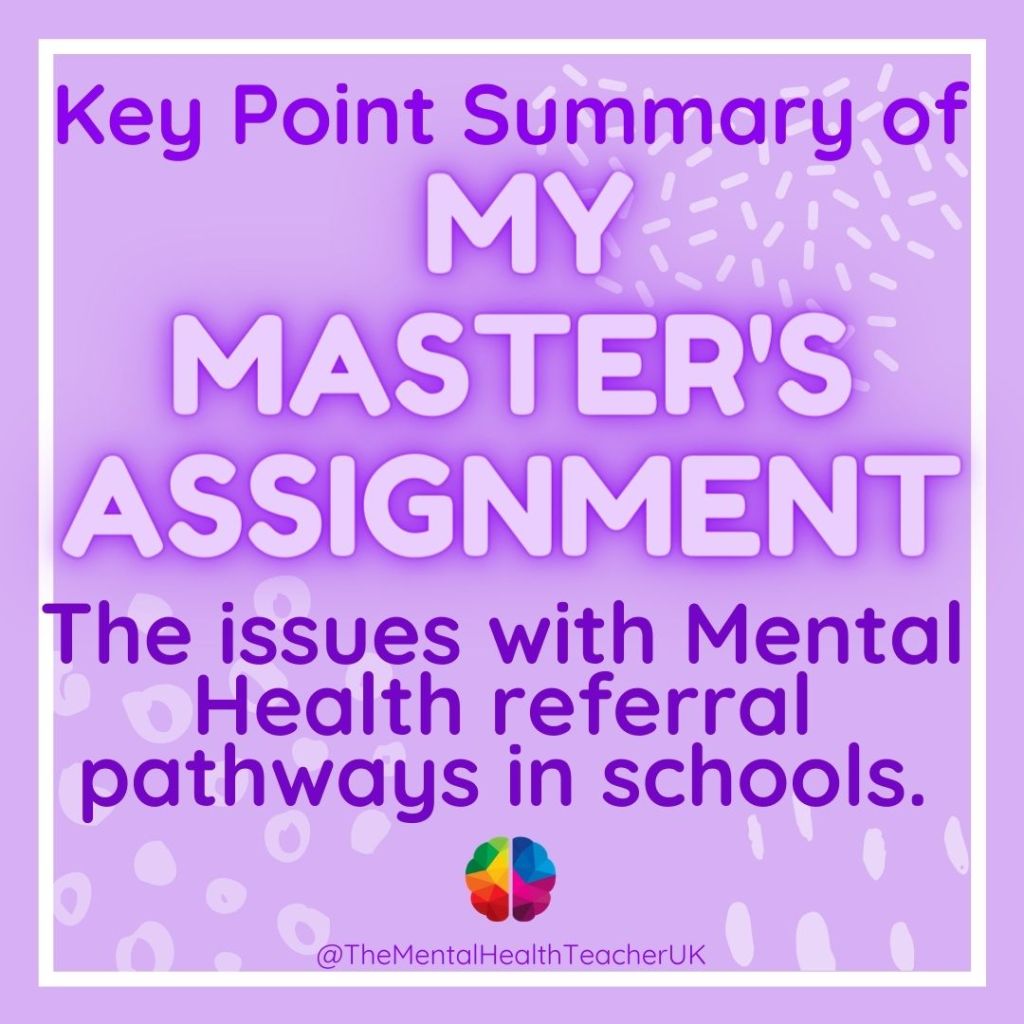
Between January and May 2021, I studied at the University of Derby for my Master’s Level 7 module: Children and Adolescent Mental Health and undertook a wide range of research to write this study.
I studied government policies, white papers, school policies and codes of practice to previous evidence-based studies, research-based studies and theories to form my understanding on the subject (I have put the 45+ bibliography at the end of bottom of this page).
Let’s start with an outline of children’s mental health in England today:
Mental health problems are consistently rising for the children and young people (CYP) in Britain, with behavioural and emotional disorders being the most common among 5-10 year olds (World Health Organisation, WHO, 2020). 16% of CYP have a probable mental health disorder (NHS Digital,
2020) which is the equivalent of nearly 5 children in every class of 30; an increase from 11.2% in 2017, 10.1% in 2014 and 9.7% in 1999 (NHS digital, 2017).
The Young Minds survey (2020) reported that a combined total of 83% of CYP said that the pandemic had made their mental health either ‘a bit’ or ‘much worse’ and compared to in 2017/18. Please bear in mind that the 2020 study was conducted in July and August, after the first (of three) lockdowns in England so this may be a modest number.
Why is it on the rise?
I believe it is due to the increase in social media, where online bullying and a reduction in face-to-face communication has been a secondary effect, the exam pressures that pupils now face, the pressure to look a certain way, as portrayed by celebrities and influencers we are bombarded with in marketing campaigns online and in the street and of course, COVID-19.
This increase in the amount of CYP needing professional help will add to the already extremely long waiting lists for referrals. Before the schools started back in January 2021, you could already be waiting up to 87 days before you are even seen for an initial meeting; with the country’s average being 43 days.
This is not good enough. Improved mental wellbeing is widely attributed to early identification of an issue and early intervention (Future in Mind, 2015). The time that it takes to be seen will be time that impacts on the child’s self-esteem, their self-understanding and acceptance and their education.
The government have started to introduce Mental Health Support Teams into schools (DH & DFE, 2017) which would help to shorten this waiting period, but these are still being set up and trialled in trailblazer areas (NHS, 2021). They are devised to give timely support but with 11% of clinical posts in CYP’s services being vacant (Kings Fund, 2018), staff will not be able to meet the demand. The government have ringfenced £79 million for the creation of these teams (DH, 2021) but this money would be better spent on recruiting and training more mental health professionals to meet the demand and shorten waiting times.
The Teachers’ Standards (DFE, 2013) state in the preamble that “teachers make the education of their pupils their first concern” (page 10). According
to Maslow’s Hierarchy of Needs (Cherry, 2018), people need to feel safe and secure and have their physiological needs met before they can learn.
Surely pupils’ health and wellbeing should be teachers’ first concern!? If children aren’t happy and healthy then we know this is a huge barrier to learning. Let alone if they’ve had enough sleep, eaten breakfast or are suffering from mental health problems. Teaching them before their needs have been met is pretty pointless. They will struggle to retain any information and focus.
Teacher workload is already through the roof, with 7 out of 10 primary teachers reporting that workload is a serious problem in the Teacher Workload Survey (DFE, 2019) so even though many, many teachers currently put their pupils’ wellbeing first, in many areas, this could be doubling their workload. In my opinion, teaching assistants are best placed to have authority over their class pupils’ mental health. They are already managing pupils’ social, emotional and behavioural issues,
often without any formal training (Groom & Rose, 2005), so having responsibility for this is a natural progression.
Many schools do not assess teaching assistants according to the results they produce (in terms of a pupil’s progress if they have worked with them 1:1). Perhaps they could have bi-annual appraisals based around the support they have provided for the pupils’ mental health. This could motivate them to provide a service of value and could be linked to their pay grades, just as a teacher’s performance is.
Teaching assistants often have a caring nature and with professional training in identifying the first signs of mental ill health, giving mental health support to mild conditions, reporting this to the relevant teacher/member of staff/parent and contacting multiagencies for more support; I believe that pupils and TAs would thrive.
Once the current TAs have been trained, this could be added onto the Teaching Assistant Apprenticeship programmes.
I envision that there would be a part-time TA based in every class which I know isn’t currently the case in some schools and they would still support during the independent activity time in lessons and could spend pockets of time (during the register, in the morning activity, during assembly, when the teacher is giving the class input, etc) focusing on their mental health responsibilities.
What do you think about using your teaching assistants in this way?
Bibliography
American Psychiatric Association (2013). Diagnostic and Statistical Manual of Mental Disorders. 5 th edition (DSM-V). Arlington, VA.
Attention Deficit Disorder (ADD) Association (1998). ADHD: The Facts. Adapted and updated from Peter Jaska’s article, “ADHD Facts” originally posted on the ADDA website in 1998 although an updated date was not given. Available at: https://add.org/adhd-facts/ (Accessed: 9.5.21)
Bennathan, M. (2018). The Boxall Profile Handbook (revised). London: The Nurture Group Network Ltd.
Burns, TP. (2004) Community Mental Health teams: A guide to current practices. Oxford: Oxford University Press; 2004.
CanChild Research Centre (2021). Related Disorders. Do some children with DCD have other developmental disorders? Available online: https://canchild.ca/en/diagnoses/developmental-
coordination-disorder/related-disorders (Accessed: 12.5.21)
Cherry, K. (2018). The Five Levels of Maslow’s Hierarchy of Needs. Available at: https://www.verywellmind.com/what-is-maslows-hierarchy-of-needs-4136760 (Accessed: 12.5.21)
Cherry, K. (2021). How Experience Changes Brain Plasticity. Available at:
http://www.verywellmind.com/what-is-brain-plasticity-2794886 (Accessed: 12.5.12)
Children’s Commissioner, CCO (2020). The state of children’s mental health services 2020/21. London: Children’s Commissioner.
Chung, P. J., Patel, D. R., & Nizami, I. (2020). Disorder of written expression and dysgraphia: definition, diagnosis, and management. Translational paediatrics, 9 (Suppl 1), S46–S54.
Curatolo, P., D’Agati E., and Moavero R., (2010). The Neurobiological Basis of ADHD. Rome, Italy, Italian Journal of Pediatrics, 36 (1), 79.
Department for Education, (2013). Teachers’ Standards. Guidance for school leaders, school staff and governing bodies. London: Department for Education.
Department for Education, (2019). Primary PE and Sport Premium Survey. Research Report. London: Department for Education.
Department for Education, DFE and Department of Health, DH (2015). The Special Educational Needs and Disability Code of Practice: 0 to 25 years. Statutory Guidance for organisations which work with and support children and young people who have special educational needs or disabilities. London: Department for Education and Department of Health.
Department for Education, DFE (2020). The National Curriculum in England. 2020 Update. London: Scholastic.
Department for Education, DFE (2019). Teacher Workload Survey 2019. Research Brief. London: Department for Education.
Department of Health, DH (2015). Future in Mind. Promoting, Protecting and Improving Our Children and Young People’s Mental Health and Wellbeing. London: Department of Health and NHS England.
Department of Health, Department for Education. (2017) Transforming Children and Young People’s Mental Health Provision: A Green Paper. London: Her Majesty’s Stationery Office.
Department of Health, DH. (2021). £79 million to boost mental health support for children and young people. Available at: https://www.gov.uk/government/news/79-million-to-boost-mental-health-
support-for-children-and-young-people (Accessed: 12.5.21)
Dyspraxia Foundation (2019). Dyspraxia in adults: a neglected and hidden disability. Available at: https://dyspraxiafoundation.org.uk/dyspraxia-in-adults-a-neglected-and-hidden-disability/ (Accessed: 12.5.21)
Fusar-Poli P, Rubia K, Rossi G, Sartori G and Balottin U. (2012) Striatal dopamine transporter alterations in ADHD: pathophysiology or adaptation to psychostimulants? A meta-analysis. Am J Psychiatry. 169 (3): page 264-72.
Goodman, R. (2005). Strengths and Difficulties Questionnaire. Available online: https://www.mentallyhealthyschools.org.uk/media/2041/sdq-uk-english-single-side.pdf (Accessed: 12.5.21)
Groom, B and Rose, R. (2005). Supporting the Inclusion of Pupils with Social, Emotional and Behavioural Difficulties in the Primary School: The Role of Teaching Assistants. Journal of Research in Special Educational Needs. Volume 5. Issue 1. Page 20-30.
Hoogman, Dr. M, PhD., et. al., (2017). Subcortical brain volume differences in participants with attention deficit hyperactivity disorder in children and adults: a cross-sectional mega-analysis. The Lancet Psychiatry, Elsevier.
Institute for Government Analysis (2021). Timeline of UK coronavirus lockdowns, March 2020 to March 2021. Available at: https://www.instituteforgovernment.org.uk/sites/default/files/timeline-
lockdown-web.pdf (Accessed: 8.5.21)
Martin N., Piek J., and Hay D. (2006). DCD and ADHD: a genetic study of their shared aetiology. Human Movement Science. Volume 25, Issue 1, Pages 110-124
Mayes, S. D., Breaux, R. P., Calhoun, S. L., & Frye, S. S. (2019). High Prevalence of Dysgraphia in Elementary Through High School Students With ADHD and Autism. Journal of Attention Disorders, 23(8), 787–796.
Mental Health Commission (2006). Multidisciplinary Team Working: From Theory to Practice; Discussion Paper. Ireland: Mental Health Commission.
Mental Health Foundation and Camelot Foundation (2006). Truth hurts: report on the national inquiry into self-harm among young people. London: Mental Health Foundation.
National Institute for Health and Care Excellence, NICE (Updated in 2019, published in 2018).
Attention deficit hyperactivity disorder: diagnosis and management. NICE guideline [NG87]. London: NICE.
National Institute for Health and Care Excellence, NICE (no date). SCOPE. Attention deficit hyperactivity disorder: diagnosis and management of ADHD in children, young people and adults. Available at: https://www.nice.org.uk/guidance/cg72/update/CG72/documents/attention-deficit-hyperactivity-disorder-adhd-final-scope2 (Accessed: 12.5.21)
NHS Digital (2017). Mental Health of Children and Young People in England. London: NHS Digital.
NHS Digital (2018). Mental Health of Children and Young People in England, 2017. Survey Design and
Methods Report. London: NHS Digital.
NHS Digital (2020). Mental Health of Children and Young People in England, 2020. Wave 1 follow up to the 2017 survey. London: NHS Digital.
NHS Digital (2020b). Mental Health of Children and Young People in England, 2020. Wave 1 follow up to the 2017 survey. Survey design and Methods Report. London: NHS Digital.
NHS (2021). Transforming children and young people’s Mental Health Support Teams and pilots Available at: https://www.england.nhs.uk/mental-health/cyp/trailblazers/mh-support-teams/ (Accessed: 12.5.21)
Pffefer, C and Ozborne, I. (2017). The Fictions Surrounding ADHD and the “Chemical Imbalance” Theory of Mental Illness. Available at: https://wakeup-world.com/2015/09/06/the-fiction-of-adhd-
and-the-chemical-imbalance-theory-of-mental-illness/ (Accessed: 9.5.21)
Reed, G. M., et al., (2019). Innovations and Changes in the ICD-11 Classification of Mental, Behavioural and Neurodevelopmental Disorders. World Psychiatry: Official Journal of the World Psychiatric Association vol, 18,1 3-19.
School Governors (2020). Special Educational Needs and Disabilities (SEND) Policy. Accessed on the school website. *Author and location are omitted to adhere to confidentiality.
The Health Foundation (2020). Generation COVID-19. Available at:
https://www.health.org.uk/publications/long-reads/generation-covid-19 (Accessed: 8.5.21)
World Health Organisation, WHO (2010). The International Classification of Diseases for Mortality and Morbidity Statistics. 10th Revision (ICD-10). Geneva: World Health Organization.
World Health Organisation, WHO (2018). The International Classification of Diseases for Mortality and Morbidity Statistics. 11th Revision (ICD-11). Geneva: World Health Organization.
World Health Organisation (2020). Adolescent mental health. Available at:
https://www.who.int/news-room/fact-sheets/detail/adolescent-mental-health (Accessed: 8.5.2021)
Youth Sport Trust (2018). YST. Timeline of the Premium. Available at:
https://www.youthsporttrust.org/timeline-premium (Accessed: 12.5.21)
